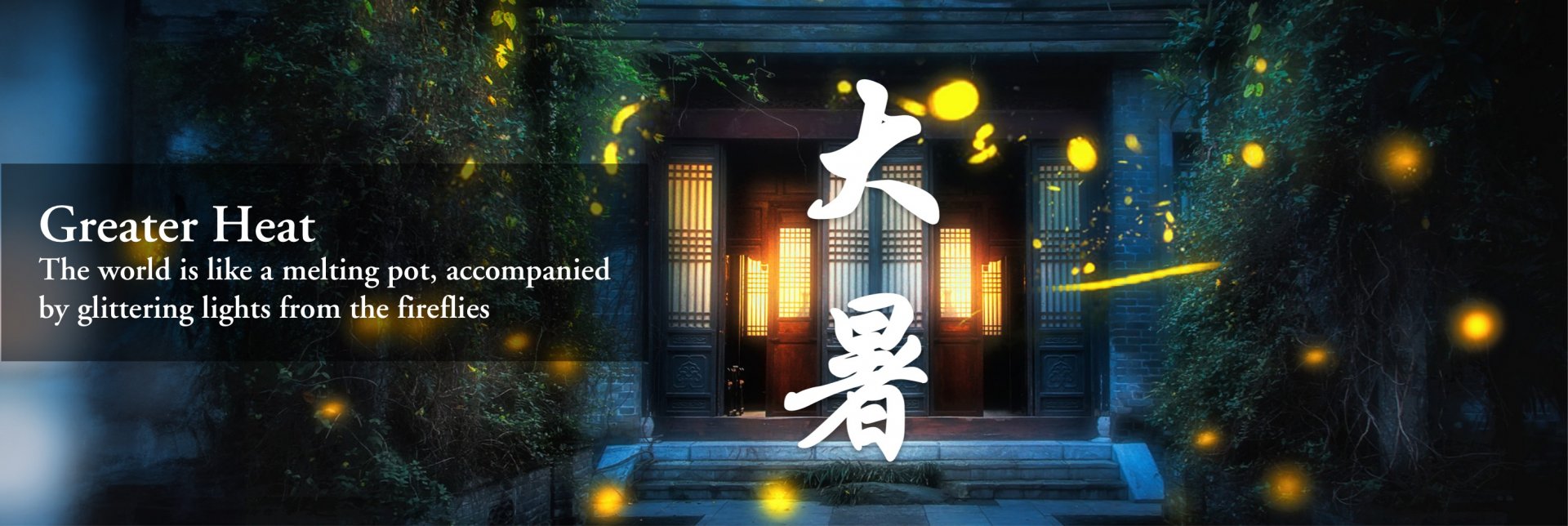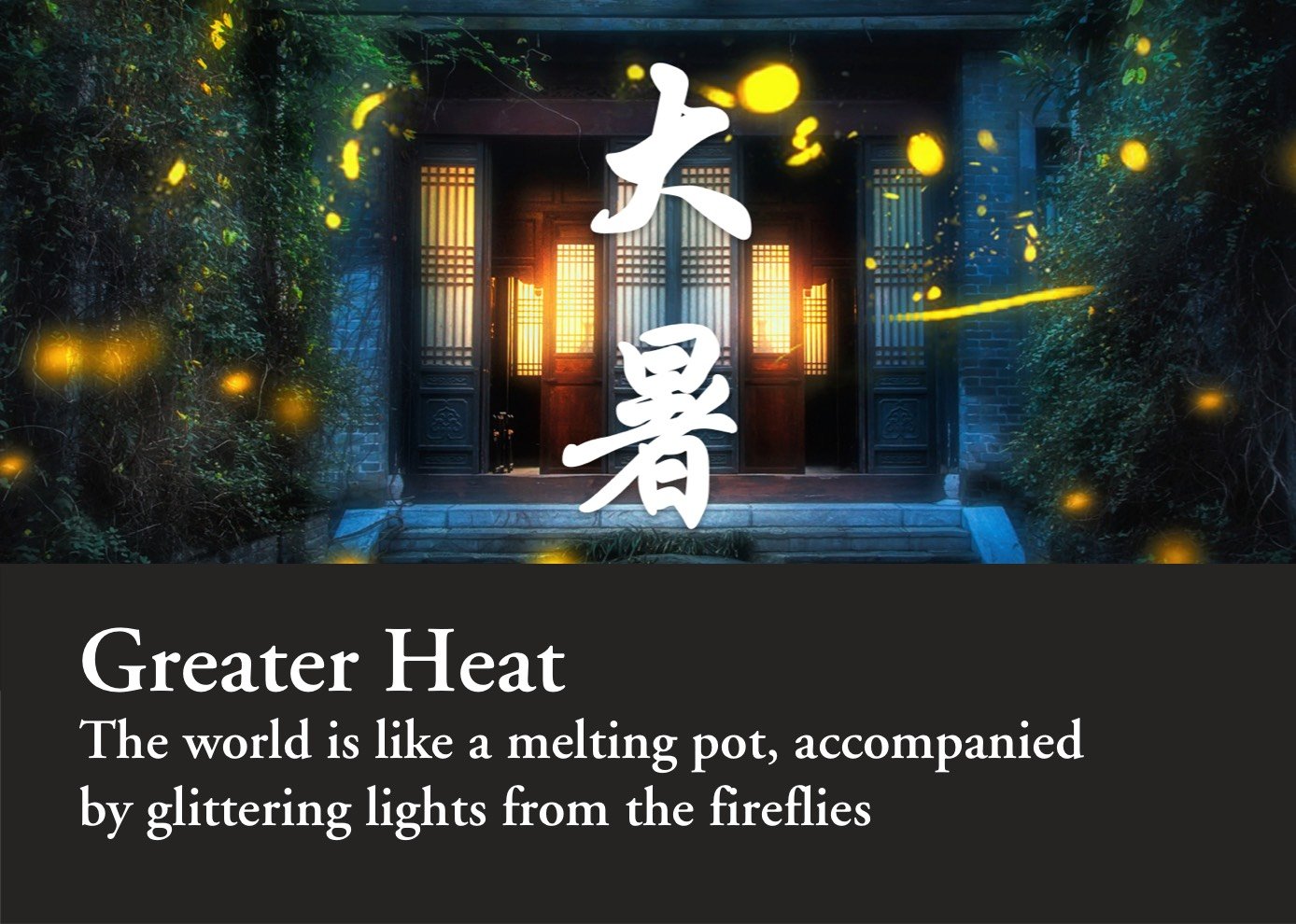Greater Heat :The world is like a melting pot, accompanied by glittering lights from the fireflies
In the campus of Xiamen University founded by the famous Southeast Asian Chinese expat Mr. Tan Kah Kee (陳嘉庚, 1874-1961), there are two academic buildings with beautiful and thoughtful names: Ying Xue Lou (映雪樓, meaning Building of the Reflection of Snow) and Nang Ying Lou (囊螢樓, meaning Building of the Glittering of Fireflies). I studied at the Xiamen University in the nineteen-eighties, when I had to attend lectures in these two buildings. The names of these two buildings were allusions from two Jin Dynasty (晉代, 266-420) celebrities: Sun Kang (孫康, 390-?) and Che Yin (車胤, circa 331-401). Both of them grew up in poor families, so they could not afford lighting oil lamps for studying at night. Sun Kan studied at night with the dim light reflected from the snow, while Che Yin gathered fireflies to generate dim lights for reading. Alongside with other two classic stories “tying one’s hair on the house beam to prevent sleeping during studying” (Xuanliang 懸樑) and “jabbing ones’ own upper thigh to wake one up (Cigu, 剌股)”, these stories became the eptiome of inspirational messages to students. In the poem “I feel so happy to see my brother Shu again thus I write a long poem for him (喜弟淑再至為長歌)” written by Tang Dynasty Poet Li Bo (李渤, 773-831), the allusion was adopted to eulogize his brother, “My second elder brother persevered in the face of adversity in his life. He studied at night with the light of fireflies in summer and the light reflected from the snow in winter 次兄一生能苦節,夏聚流螢冬映雪)”. These two stories were even incorporated into Children’s book Three Character Classic, “Then we have one who put fireflies in a bag, and again another who used the white glare from snow. Although their families were poor, these men studied unceasingly (translated by Herbart Gilles)”. Since then the stories have become household classics.

People often regard small fireflies as insignificant. Nonetheless, the significance of firelies was officially recognized in the descriptions of The History of Jin – The Biography of Che Yin (晉書·車胤傳), “In summer, he caught several tens of fireflies and put them in a silk pouch for lights to read at night” (夏夜以練囊盛數十螢火蟲以照書), which made the dim light of fireflies lighten up subsequent generations.
Being regarded as the sign of arrival of the Greater Heat (大暑), the last solar term in the summer, fireflies also shared an important role in cultures related to ancient Chinese calendars. The emergence of Greater Heat was denoted as “rotten grass transformed into fireflies” (腐草為螢).
Fireflies could be divided into terrestrial type and aquatic type. Terrestrial type lay eggs among rotten grasses and plants. Thus, ancient Chinese misunderstood that fireflies were transformed from rotten grasses. It is worth noting that signifying features of the solar term (物候) often deliver messages from the nature, sign-posting the forthcoming of significant seasonal changes.
Ancient Chinese highly regarded fireflies as the major feature of the solar term of Greater Heat. We could find two lessons from this: First, ancient Chinese made meticulous observations to the nature, without overlooking tiny features; second, as fireflies were regarded as the signifying feature of one of the most important solar terms in ancient times, it bore significant meanings in foretelling changes of seasons and weathers.
This provides an insight that we should respect the nature, which includes all tiny creatures. We should not just focus on the bigger ones but ignore the tiny ones, as the variations among tiny creatures often serve as providing the “electrocardiography” of the nature that records its vibes. Tiny fireflies therefore bear significant meanings.
The subsequent speculations over relative relationships between “the big” and “the tiny” fireflies make us further ruminate about the dual nature of Greater Heat: On one hand, the succession from Lesser Heat to Greater Heat is characterized by the steaming weather from the sky and heating from the ground, accompanied by scorching heat, incessant thunders and storms. The unpleasant weather brings lots of troubles and annoyance to our daily lives. On the other hand, as mentioned in Lost Book of Zhou (逸周書), during this solar term, “the earth moistens in the humid summer” (土潤溽暑), and “the rain pours every now and then” (大雨時行). This provides a favourable environment for the rapid growth of all organisms and momentum for the crops to store more nutrients, which bring benefits to human beings.
Such wisdom leads to various farmers’ proverbs, for examples, “Hot weather not only makes us irritable at home, but also makes crops laugh in the field (人在屋裏熱得燥,稻在田裏哈哈笑)”, “If there is no scorching weather in Greater Heat, it is highly probable that crops will not ripe (大暑無酷, 五殼多不結).”
Ancient authors and poets also recognized these farmers’ proverbs. For example, Southern Song Dynasty poet Dai Fugu (戴復古, 1167- circa 1248) wrote Five Poems of Great Heat, with the first poem describing the the heaven and earth in the sixth month of the year is as hot as a big porcelain kiln, but even so we should not blame the scorching heat, as “everything in the world is cultivated here like the formation of porcelain in this kiln (萬物此陶鎔)”. Things are growing and thriving in the hot summer, therefore they can ripe in the autumn, “Don’t you know that crops could ripe in autumn is due to the formation in the hot summer (君看百穀秋,亦自暑中結)”.

Before and after Greater Heat is exactly Zong-fu (中伏, the middle “fu” day), which is the second of the three Fu days (三伏天). In order to maintain ones’ physical and mental health, Chinese people have developed plenty of customs to get relief from the summer heat. In some places, people drink Fu Cha (伏茶), a type of herbal tea made from Honeysuckle (金銀花), Common Selfheal Fruit-Spike (夏枯草) and Licorice (甘草), to cool onself down and dispel inner heat. In some places, people eat herbal jelly – which is regarded as both medicine and food- to cool onself down and detoxify. In some places, people burn Fu Incense (伏香) for two purposes. The first purpose is to make a wish for good harvest, while the second purpose is to dredge all channels through burning the acupoints of human body, so as to maintain physical health. Apart from that, there are also other places where Greater Heat Festival (大暑節) and Half-Year Reunion (半年圓) are celebrated. All these customs aim to keep one’s good health by adapting to the season.

Anicent Chinese referred “Great” in Greater Heat to the extreme heat. It is the law of the nature that everything goes up must go down. After the Greater Heat, it is followed by the solar term of The Beginning of Autumn (立秋). However, even when the beginning of autumn arrives, one can still find the remnant of the summer. While the natural phenomenon of “Autumn Tiger” (秋老虎, unexpected hot weather in the autumn) is the most evident example, the fireflies mentioned above are still flying in the cool breeze in autumn nights. The cooccurence of these phenomena were popular scenes in literature. For example, Xie Tiao (謝朓, 464-499) mentioned in his poem “Sentiment on the Jade Stairs” that “Lowering the pearl window sill in the palace at the dusk, fireflies were flying then took a rest.” (夕殿下珠簾,流螢飛復息). Also, Du Mu (杜牧, 803-852) wrote in An Autumn Night (秋夕) that “pale candle shades the autumn light to cool down the screen, she shoos aways fireflies with her silk fan (銀燭秋光冷畫屏,輕羅小扇撲流螢)”. These great lines remind us that there are also many beautiful ruminations of the season despite the scrotching weather in the Greater Heat.
參考資料
書籍
1. 石夫、韓新愚編著:《不可不知的中華二十四節氣常識》(鄭州:中原農民出版社,2010年)。
期刊文章
1. 楊玫玫、譚元元、王偉躍:〈我國二十四節氣的氣候特點淺析〉,《農業災害研究》,第10期(2022年)。
2. 霍福:〈二十四節氣在兩種語境中的邏輯表達〉,《貴州民族大學學報(哲學社會科學版)》,第2期(2018年)。
All articles/videos are prohibited from reproducing without the permission of the copyright holder.




Welcome to leave a message:
Please Sign In/Sign Up as a member and leave a message